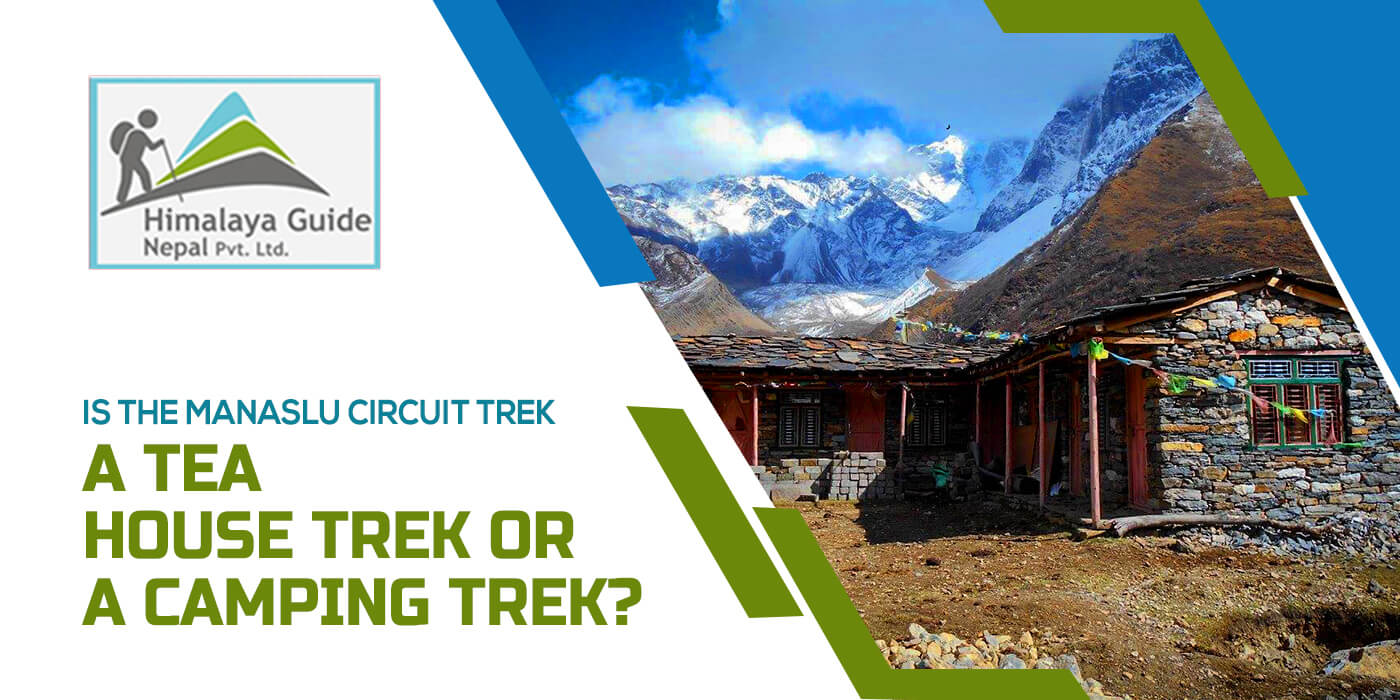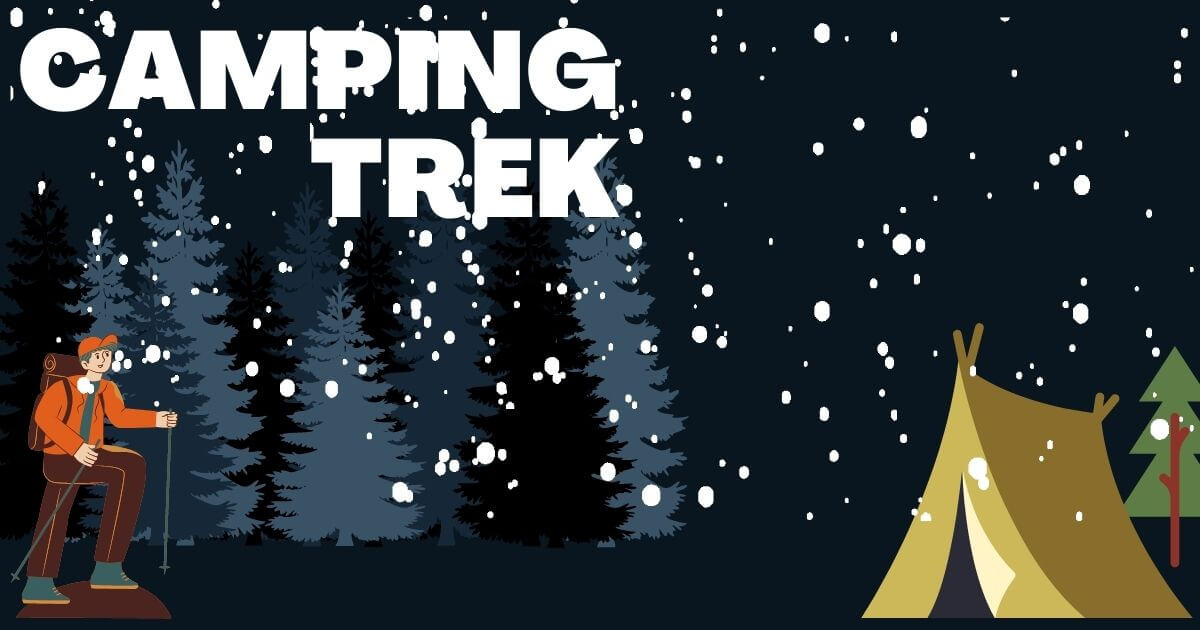Is Manaslu Circuit Trek a Camping Trek or Tea-house Trek ?

16 Feb 2023 Chandra Gurung
Overview
A tea house trek is an expedition where you stay in local lodges or tea houses along the path rather than camping trek. Tea house trekking is popular in many places, especially Nepal’s Himalayan area. Both camping and teahouse accommodations are options for the Manaslu Circuit Trek. Now Let’s find out” Is the Manaslu Circuit Trek a camping trek or tea-house trek ?”
Tea house trekking is typically less expensive than tent trekking because you pay for lodging and meals along the route. It is also more convenient because you do not have to carry any camping equipment or employ a crew of porters.
A tea house hike may be the best option if you want a more pleasant and accessible trekking experience.However, tea house trekking may be less intimate and adventurous than tent trekking because you will stay in more inhabited places and be more open to society.
Which One Is Better: Tea-house Trek or a Camping Trek?
Camping trekking is often more expensive than tea-house trekking since you must pack your camping equipment and hire a porter crew to transport it. However, camping gives greater freedom in terms of where you stay and when you begin each day’s trip, as well as a deeper absorption into the environment.
Tea-house trekking is typically cheaper because you only need to pay for your hotel and meals along the route. It is also more convenient because you do not need to carry any camping equipment and can find food and lodging in communities along the way.
Finally, your particular tastes and what you hope to gain from your walk will determine your ideal option.A camping trek involves camping in designated campsites along the path, whereas a tea-house trek involves staying in local hotels or tea houses. Both choices offer advantages and disadvantages, and the decision will be based on your tastes, money, and time restrictions.
How is Food in Tea House in Manaslu Circuit Trek?
The chance to sample the local cuisine while hiking is always fantastic. Dal-Bhat is a traditional Nepalese meal that is both satisfying and healthful. The tea houses cook their dishes using locally sourced foods. However, the most important aspect of the food they give is that local agro-products are used to prepare most of it.
The food is clean and nutritious, which is very important when travelling in a remote location. It’s critical to feed up correctly when hiking, and having access to nutritional meals may make a big difference in how one feels throughout the journey.
The variety of meals on the tea house menus that you described sounds interesting, and it gives a decent range of alternatives for hikers with varying dietary requirements. It is always the case.
It’s always wonderful to sample new cuisines and taste the flavors of a different culture. A Dal-Bhat set, a selection of potatoes, curries, rice, noodles, pasta, spring rolls, and soup with seasonal vegetables, would make up the basic components of a tea house’s menu. Pasta, spring rolls, and soup with seasonal vegetables would make up the basic components of a tea house’s menu.
What is the Cost of Tea House Manaslu Circuit Trek?
Depending on the location, time of year, and services provided, the pricing of the tea houses along the Manaslu Circuit trek might change. However, a reasonable room at a tea house can range in price from NPR 200-500 (about USD 2-5) each night.
Remember that if you dine at their restaurant or stay numerous nights, certain tea houses may discount your stay and meals. When making a reservation, it’s a good idea to ask for a discount or negotiate the price, especially during the low season.Some tea houses charge less for shared rooms, while others charge more for private rooms with attached bathrooms.
Due to the practical issues of bringing goods to the rural area, the cost of meals and beverages at tea houses may be higher than in cities.Overall, tea houses along the Manaslu Circuit trek are reasonably priced, making it a popular choice for budget-conscious trekkers.
Tea house treks on the Manaslu Circuit offer several advantages:
- One of the primary benefits of a tea house walk is the availability of pre-existing lodging, eliminating the need to carry camping equipment or rely on a specialized Trekking staff to set up camp each night. Instead, stay in a small tea house along the trekking path for a more comfortable and convivial atmosphere.
- Another plus point of a tea house trip is the flexibility it provides. You may change your schedule and speed according to your physical condition, hobbies, and weather, so you may take leisure days as required or explore side paths without bothering to set up camp.
- Tea houses frequently provide a variety of comforts and services, such as hot baths, Wi-Fi, and charging stations. The tea house is especially useful for those who want a higher degree of comfort or need to keep connected while on the road.
- A tea house trek may be more affordable than a camping trip because you won’t need to pay for camping gear, a dedicated trekking crew, or wilderness camping permits. That may make it more affordable for budget-conscious tourists.
- Interaction with locals and their culture: Staying at tea houses offers a special chance to get to know locals and experience their culture personally. You may sample regional cuisine, learn about traditional practices, and better understand the region’s history and way of life.
Overall, a tea house trip may provide a comfortable, friendly, and adaptable trekking experience while maintaining an element of adventure.
How is Food in Camping Trek in Manaslu Circuit trek
On camping trips, the trekking crew normally cooks the food, such as the cook or kitchen staff. The food offered will vary depending on the route and location in which you are walking. You can get a combination of local and Western-style food, snacks, and hot drinks.
Camping meals are typically basic, but it is still delicious and healthy. Dalbhat, noodles, pasta, rice, soups, curries, and vegetables are typical meals. The cook will often utilise locally obtained products, such as fresh vegetables and meat. However, this can vary based on the availability of goods in the location.
You must inform your trekking company if you have any diet plans or likings. Vegetarian, vegan, and gluten-free meals are frequently available but check with your trekking company carefully.
Overall, while the cuisine on camping trips is not as rich or broad as that served in tea houses, it is nevertheless delicious and healthy. In addition, having a meal in the presence of nature while being served by a skilled trekking staff may be a memorable and delightful aspect of your trekking expedition.
What is the cost of Camping trips in Manaslu Circuit Trek

The cost of food on a Manaslu Circuit Hike tent trek varies based on the trekking service and the schedule. Food is usually included in the overall cost of the walk, and the trekking organisation will give three meals and snacks daily.
Due to the transportation difficulties in getting supplies to distant places, it’s essential to remember that the cost of food and other services on a camping trip may be more than on a tea house trip. A camping trek, on the other hand, may include additional services such as a trekking guide, porters, permits, and equipment that are not included in the cost of a tea house trek.
The price of a camping trek in Manaslu Circuit Walk varies according to the trek’s length, the party’s size, and the services supplied by the trekking company. A 14-day camping trip with a fully prepared camping crew, including meals, may cost between USD 1,500 and USD 2,500 per person.
Before scheduling a camping trek in Manaslu Circuit Trek, research and compare the pricing and services provided by various trekking service providers, it’s also a good idea to double-check what’s included in the price and whether there are any additional prices or hidden fees.
Camping treks on the Manaslu Circuit offer several advantages:
- Camping treks may take you to isolated and undisturbed nature locations that tea house treks cannot, resulting in a more real and immersive trekking experience with fewer crowds and a stronger connection to nature.
- A camping trip may provide a higher sense of adventure by allowing you to explore more difficult paths and rough terrain. That might be particularly luring to experienced hikers seeking a more harrowing and realistic trekking experience.
- A camping trek might provide greater freedom in terms of schedule and speed. With your hiking team and equipment, you may tailor your itinerary and route to your interests and physical ability.
- On the other hand, a camping journey can give a more realistic, immersive, and customised trekking experience, with access to more distant and pristine wilderness locations. It is an excellent choice for rough and hard trekking journey lovers who are OK with spending nights in tents without access to the comforts and services offered by tea houses.
Conclusion
Which Manaslu Circuit Trip option is preferable—a tea house trek or a tented trek—depends on the traveller’s tastes and way of travel.
On the other hand, a camping trek may provide a more interactive and adventurous experience, with the opportunity to explore more distant locations and enjoy a deeper sense of isolation and connection with nature.
A tea house trip can provide the advantages of pre-existing lodging, access to additional conveniences and services, and the opportunity to connect with local people and culture. A tea house trip may be a more comfortable and social choice for some people who prefer a warm bed and a hot shower at the end of a day of hiking.
It is important to properly evaluate the benefits and drawbacks of each trekking option .To determine which is the greatest fit for your interests, physical skills, and travel preferences. Both tea house and camping hikes may be worthwhile and remarkable experiences, and the decision ultimately depends on the adventure you want.
